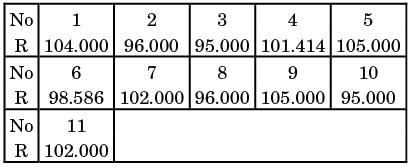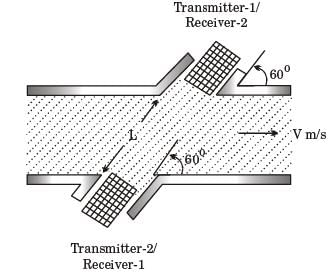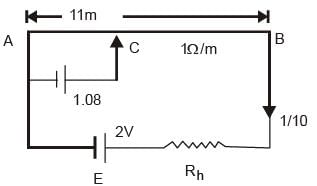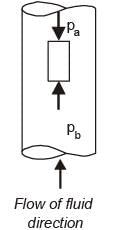Test: Sensor & Industrial Instrumentation- 3 - GATE MCQ
25 Questions MCQ Test - Test: Sensor & Industrial Instrumentation- 3
A wire potentiometer of length 11 m and resistance 1 Ω/m balances a standard cell voltage of 1.018 V at a length of 10 m 18 cm. If the voltage of the battery supplying the current through the potentiometer is 2.0 V, then the value of the series resistance connected to the potentiometer is (2004)
A 3½ digit multimeter has an accuracy specification of (± 0.5% of reading ±5 counts). If the meter reads 2.00 mA on a full scale of 20 mA, the worst-case error in the reading is (2003)
A temperature-measuring instrument is modeled as a first-order system with a time constant of 5s. The sensor of the instrument is placed inside an oil bath whose temperature has a sinusoidal variation with an amplitude of 10° C and a period of 20s around an average temperature of 200° C. The sinusoidal component at the output of the instrument will have amplitude. (2003)
The table provides the thermo-emf sensitivity of five materials concerning platinum around 273 K (2003)

Q. The thermocouple pair that gives the maximum sensitivity around 273 K is
The table provides the thermo-emf sensitivity of five materials concerning platinum around 273 K (2003)

Q. Two copper-constantan thermocouples are connected such that the two constantan wires are joined together. The two copper wires are connected to the input of a low noise chopper stabilized differential amplifier having a gain of 1000. One of the thermocouple junctions is immersed in a flask containing ice and water in equal proportion. The other thermocouple is at a temperature T. If the output of the amplifier is 2.050 V, the temperature T is
An N-type semiconductor strain gauge has a nominal resistance of 1000Ω and a gauge factor of -100. The resistance of the gage, when a compressive strain of 100 m/m is applied, is (2003)
A piezoelectric type 50 MPa full-scale pressure sensor with built-in electronics has a sensitivity of 100 mV per MPa. If this sensor is subjected to a static pressure of 10 MPa, then its output will be (2002)
A thermocouple is suddenly immersed in a medium of high temperature. The approximate time taken by the thermocouple to reach 98% of the steady-state value is (2002)
A capillary viscometer with known dimensions is used for measuring the dynamic viscosity of the oil. To obtain viscosity, it is necessary and sufficient if one measure (2002)
The sensing element of a thermocouple at its hot junction is provided with a shield while taking measurements in a high-temperature gas. The principal reason for giving the shield is (2002)
Three DC currents I1, I2, and I3 meet at a node with I1 entering and I2 and I3 leaving the node. I1 and I2 are measured as 100 mA and 99 mA with a ± 1% accuracy. Then the value of I3 and the accuracy of I3 are (20020
A quartz crystal (Young’s modulus, E = 9 * 1010 N / m2) with piezo-electric properties has a diameter of 10 mm and thickness of 2 mm. Its voltage sensitivity constant is 4500 V/ m. If the voltage output is 127.3 V, the applied load is approximately (2002
One method of measuring the radius of an arc (R) is to allow a roller of radius (r) to oscillate to and fro on the arc and measure the average time per oscillation, T seconds. The roller will then have a linear acceleration of 2g/3, where g is the acceleration due to gravity. m such an experiment, the value of the radius of the arc can be found from the expression: (2002)
In a rotameter, used for measuring flow rate of a fluid, Pa: pressure above the float, Pb: pressure below the float, A: area of float, V: volume of the float, d1: density of float material, d2: density of the fluid, g: acceleration due to gravity. The following equation describes the equilibrium of the float. (2002)
A batch of 11 resistors of 100 Q nominal value, when measured, gave the following readings. (2002)

Determine the % tolerance of the batch. 120Ω resistors are made using these 100Ω resistors having a tolerance of 3%. Determine the tolerance of the 120Ω resistors.
Q. A 100/1 A, 5 VA UPF bar primary current transformer (CT), when measuring 100 A draws a magnetizing current of √2∠45A. Reference phasor is the flux in the core. Determine the ratio and phase errors of the CT. If one turn were removed from the secondary of the CT, then what would be its ratio and phase errors?
The expression for the capacitance (C in pF) of a parallel plate capacitor is given by: C = 6.94 x 10-3 (d2/S). The diameter (d) of each plate is 20 mm, and the spacing between the plates (S) is 0.25 mm. The displacement sensitivity of the capacitor is approximate: (2002)
The radius of a sphere is given as (40.0 ± 0.5) mm. The estimated error in its mass is: (2002)
Threshold of a measurement system is (2001)
The refractive indices of glass and water are 1.50 and 1.33, respectively. If the glass is immersed in water, its relative refractive index is (2001)
Figure given below shows an ultrasound flowmeter with the transducers separated by a distance L = 25 mm with the line joining the transducers, making an angle 60° with the flow direction. The transit time difference between upstream and downstream measurements is 10 ns, with the sound velocity in the medium being 1000 m/s. Assuming that the size of the transducers is very small as compared to the diameter of the pipe, the flow velocity is

A strain gauge is attached to a bar of length 20 cm, which is subjected to a tensile force. The nominal resistance of the strain gauge is 100Ω. The changes in resistance and elongation in the bar measured are 0.35Ω and 0.2 mm, respectively. The gauge factor of the strain gauge is (2001)
In the context of transducers, identify the correct matches List I with List II:
List I
(a) mean free path
(b) humidity
(c) heat transfer coefficient
(d) intensity of radiation
List II
(p) optical pyrometer
(q) Kaudsen gauge
(r) sling psychrometer
(s) hot wire anemometer
Fill in the blank with the correct idiom/phrase.
That boy from the town was a ____ in the sleepy village. (2015)
Liquid flow rate is measured using (2015)
The torque transmitted by a cylindrical shaft is to be measured by using two strain gauges. The angles for mounting the strain gauges relative to the axis of the shaft for maximum sensitivity are (2015)












































